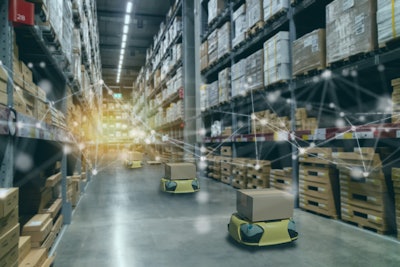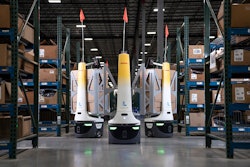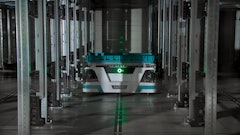
An efficient supply chain management is the key to the smooth functioning of an e-commerce business. The modern trend of delivering the goods and services in the shortest time possible has significantly increased the burden on the supply chain system. On the other hand, maintaining optimal logistics has become extremely difficult.
However, with the simultaneous evolution of technology, the e-commerce industry has figured out an effective solution to this problem. The warehouse and logistics robots have positively impacted the supply change management system and significantly reduced the hassle involved in manual management of logistics.
In this article, we will explore the role of robotics in the e-commerce warehouse and how it is helping to create a more efficient supply chain. We will also take a look at some of the challenges faced by the e-commerce industry and how robotics can help to overcome them.
Market penetration of warehouse robotics in e-commerce
Initially, very few robots were introduced into the manufacturing sector to perform some of the monotonous manufacturing operations. Eventually, many industries realized their potential across various applications. This technology has been witnessing rapid automation to enable it to reduce delivery time and streamline operations in a warehouse.
The e-commerce sector is witnessing substantial growth as the technology becomes affordable due to decreasing robot costs.
The biggest proof of this growth is the rapid adoption of warehouse and logistics robots by e-commerce giants such as Amazon and Walmart.
Recently, Walmart extended its partnership with AI supply chain tech group Symbotic, rolling out the group’s pipeline of robotic solutions and software automation platforms at all its distribution centers.
On the other hand, Amazon has announced a $1 billion investment into accelerating the deployment of digital tools such as robots and AI across its operations.
These industry leaders have recognized the potential of robotics application in the warehouse, logistics, and supply chain systems, therefore, making its best use.
According to the BIS Research market analysis, various factors such as the rising venture capital investments, growing Third Party Logistics (3PL) market, and introduction of Industry 4.0 into logistics and warehouses are also providing a great opportunity for the growth of the global logistics and warehouse robot market.
How do warehouse robots help in efficient supply-chain management?
The technological evolution enabled e-commerce businesses to scale on a global level. So evidently, technology is the visible solution to the complications related to operations at such a large scale. Warehouse automation has proved to be extremely beneficial to e-commerce businesses in many ways, such as overcoming shortage issues, supply chain tracking, and handling heavy equipment.
There are a few key-ways in which warehouse robots improve accuracy and efficiency in the workplace.
Firstly, they eliminate the need for human employees to walk around the warehouse to find items. This not only saves time, but also reduces the chances of human error. Secondly, warehouse robots can be programmed to pick up and drop off items much faster than humans. This increased speed leads to increased accuracy as there are fewer opportunities for mistakes to be made. Finally, warehouse robots can work tirelessly for hours on end without needing breaks, meaning that they can maintain a high level of accuracy and efficiency throughout their shifts.
Some additional benefits of warehouse robots are:
- Increased operational productivity and efficiency
- Reduced chance of errors, risks, and re-work
- Enhanced employee safety in high-risk work environments
- Space for manpower to focus on creative and strategic efforts that cannot be automated
- Increased revenue and profit shares by adding efficiency to the order fulfillment system, delivery speed, and customer satisfaction
- Boosted corporate brand by signalling leading-edge practices and implementation of innovative technology
- Value to the businesses through data collection and machine learning
Types of warehouse robots
Warehouse robots involve various kinds of technologies and equipment watch are used for different purposes. Few of these technologies are:
1. Autonomous mobile robots: E-commerce warehouses and logistical companies are adopting new and innovative technologies to improve operational efficiency, enhance speed, ensure precision, and increase safety. Autonomous mobile robots (AMRs) are one such solution.
They can study, analyze, and move through their environment independently. AMRs are a progression from their predecessors, autonomous guided vehicles (AGVs), which relied on predefined paths and often required operator supervision.
AMRs use enhanced sensors, artificial intelligence, and machine learning to compute the path to interpret and navigate through the space, untethered from wired power. These robots are also equipped with cameras and sensors. Hence, when they experience an unexpected obstacle, such as a fallen box or a crowded space, they use a navigation technique like collision avoidance to slow, stop, or change their path around the object and continue the task. These are used in warehouses to cut down redundant tasks to reduce errors.
2. Aerial drones: These devices are used to optimize warehouse inventory processes. The warehouse drones, also known as unmanned aerial vehicles (UAVs) perform tasks such as inventory audit, cycle counting, and stock finding.
They fly autonomously to scan and count the stocked materials in the warehouse and compare them with the data stored in the software, enabling safe and low-cost inventory operations. These drones can easily navigate without taking up much space, which makes it easy to reach inaccessible spaces.
3. Automated storage and retrieval system (AS/RS): These are computer- and robot-based systems that can store or retrieve items in specific locations. These comprise predefined locations according to which machines can follow established routes to retrieve items.
Usually, AS and RS are used in the case of high-volume loads that need to be moved rapidly and accurately. These systems help to speed up manufacturing and shipping tasks.
Conclusion
The adoption of warehouse robots has completely changed the retail system globally. Robotics and artificial intelligence technologies have enabled an efficient and superfast supply chain system that provides products and services in the shortest time possible.
Implementing warehouse robots is a smart business decision right now. If you’re thinking of using them in your business, now is the time to do it. With proper planning and execution, you can reap all the benefits that these amazing machines have to offer.
















